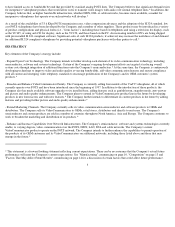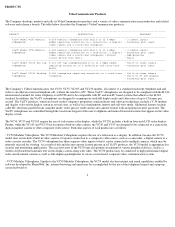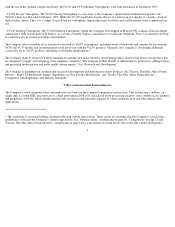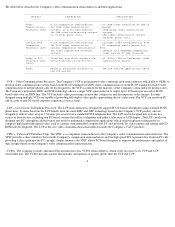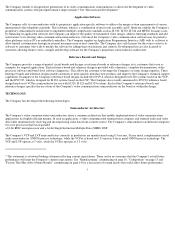8x8 1998 Annual Report Download - page 16
Download and view the complete annual report
Please find page 16 of the 1998 8x8 annual report below. You can navigate through the pages in the report by either clicking on the pages listed below, or by using the keyword search tool below to find specific information within the annual report.from selling the Company's semiconductors on the open market. Both parties have also agreed to license to each other any enhancements to the
technology which are developed by either party, unless 3Com elects to discontinue sharing at any time or the Company elects to discontinue
sharing (which it may do at any time following June 30, 2000). Any enhancements or other technology developed by 3Com cannot be
sublicensed by the Company or incorporated into semiconductors which the Company sells on the open market in component form, but can be
incorporated into semiconductors that the Company uses in the VideoComunicators. Pursuant to the Company's agreement with 3Com, the
Company was prohibited, until May 5, 1998, from licensing the technology to others, except in limited circumstances.
The KME agreement provides to KME, for a license fee previously paid in full to the Company, all of the source code and object code of the
H.324 software for 8x8's LVP semiconductor product and related development software, as well as certain board schematics (the "H.324
Technology"), and grants KME a perpetual, nonexclusive, nonassignable worldwide license to make, use or sell products with the H.324
Technology. Under this arrangement, KME also has a nonassignable option, upon payment of additional consideration, to obtain the
Company's LVP and VCP semiconductor technology for use only on systems assembled by KME or its affiliates, which would include any
entity controlled directly or indirectly by Matsushita. As a result, KME has a license to substantially all of the Company's technology
underlying its VideoCommunicators. In addition, KME must pay to the Company a royalty for any LVP or VCP semiconductor it
manufactures or any product wherein KME uses any part of the LVP or VCP semiconductor technology. Both parties agree to license to the
other party, at no charge, any enhancements to the H.324 Technology or the LVP or VCP semiconductor made by either party, until such time
as KME decides to discontinue sharing of enhancements.
The Company has licensed portions of its semiconductor, software and systems technology to others. The Company has licensed the right to
manufacture certain of its video communication semiconductors, subject to payment of royalties, to several video communication systems
manufacturers. In addition, the Company has licensed portions of its video communication semiconductor technology to ESS Technology. Of
these licensees, ESS Technology may sell semiconductors based on the licensed technology to third parties, while the other licensees are
limited to sale of such semiconductors as part of video communication systems or sub-systems. The obligation of ESS Technology to pay
royalties to the Company with regard to the sale of semiconductors based on the licensed technology, will expire in October 2000, or earlier, if
the Company exercises its right to a royalty-free license to certain technology of ESS Technology. In order to encourage the use of its
semiconductors, the Company has licensed portions of its systems technology and software object code for its semiconductors to virtually all of
its semiconductor customers. Moreover, many of the Company's OEM customers have licensed portions of the source code to its software for
its semiconductors. In addition to KME and 3Com, a number of video communication system manufacturers have licensed substantial portions
of the Company's source code.
In the years ended March 31, 1998, 1997 and 1996, technology licensing revenues (all of which were nonrecurring) were $14.5 million, $3.9
million and $9.0 million, respectively. See "Management's Discussion and Analysis of Financial Condition and Results of Operations." There
can be no assurance that the Company will receive such licensing revenues in the future. See "Factors That May Affect Future Results -- No
Assurance of Future License and Other Revenues."
In addition to licensing its technology to others, the Company from time to time will take a license to others' technology. For example, the web
browser software running on the VC55 was developed by, and is licensed from, PlanetWeb, Inc. The Company has in the past licensed and in
the future expects to continuing licensing its technology to others, many of whom are located or may be located abroad. There are no
assurances that such licensees will protect the Company's technology from misappropriation. Also, the Company's reliance on licensing
technology from third parties subjects the Company to certain risks. See "Factors That May Effect Future Results --
Dependence on Proprietary
Technology; Reliance on Third Party Licenses."
12



